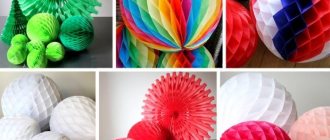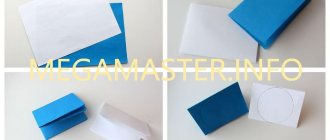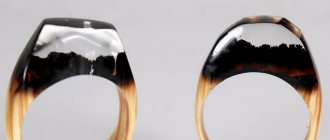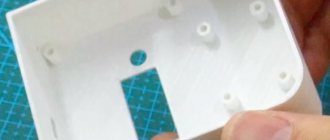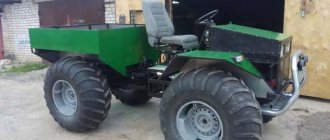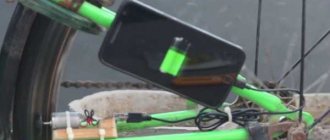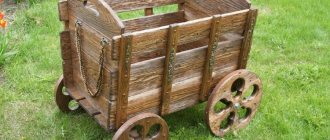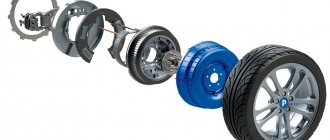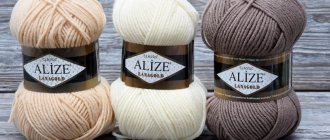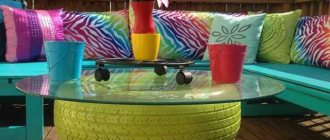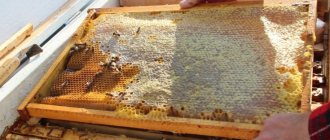How to make wheels for a car or robot
Hi all! Many DIYers who make cars or robots have encountered the problem of not having enough wheels for the model. I've been looking for a solution to the problem for six months now. Since I'm into robotics using Arduino, I often need wheels of different diameters. I'll show you how easy it is to make wheels.
To make them you will need:
-foam plastic of the required thickness (I took 30 mm); - cardboard rectangles (during the manufacturing process you will understand how long and wide they should be); -PVC tube with a diameter of 5.2 (or any other, it is used to secure the wheel to the engine); - titanium glue or equivalent; -gouache paint; -and some little things that everyone has.
The main tool is a nichrome cutter. They will need to cut out circles from foam.
Be patient and you can start.
In the future I will make a robot using these wheels.
I hope you liked this idea. I believe that this is a worthy homemade replacement for purchased wheels, in any case, I did not find a single idea on this topic on the Internet.
Source
What are buds and what are they for?
Tires (also known as low-pressure tires) are huge tractor, truck or helicopter tires that have been stripped of excess rubber.
Thanks to the large area of such wheels and their low pressure on the surface, an ordinary passenger car equipped with them becomes a real SUV .
With encouragement, Niva and UAZ can overcome a wide variety of obstacles - fields, deserts, rocky and marshy soil.
It is difficult for hunters and simply those who like to ride in difficult terrain to do without wheels with low pressure.
Making such tires yourself is not a problem. For this, the most common tools like a knife or winch . It will still take a little skill.
Before you start creating low-pressure tires, you need to clearly understand what exactly they will be needed for , that is, in what conditions, where exactly they will be used.
- primarily for driving on dirty, bumpy roads and rural roads - then you need to use a self-cleaning tread;
- If we go through swamps on tires, we will need to lower the tread grooves a little so that the grip becomes as good as possible;
- In snow drifts and sand, it is better to drive on tires on which the tread pattern elements are as close to each other as possible.
You need to think about the above in advance.
DIY radio-controlled racing car model
Good day, lovers of making things with their own hands. In today's article we will collect a rather interesting homemade product for your leisure and fun. Namely, we will assemble a radio-controlled model of a car. One of the key features of this homemade product is that it will be assembled from the most homemade and affordable components using a minimum number of purchased factory elements. This homemade product can in no way be classified as a serious model, but it can easily outperform any toy model from a children's toy store and, in addition, have greater functionality (in terms of the number of different settings). This homemade product may be inferior to toys only in appearance, but here everything depends on you.
You can find links to some of the design components at the end of the article.
For this radio-controlled car model you will need the following, namely:
— Metal axles — 20mm plastic pipe — Bearings — Wheels 4 pcs — A small piece of rubber (for example, from a bicycle tube) — Aluminum profile (the one used for installing drywall) — Electric motor — Small sheet of plywood — Plastic ties — Metal washers — Bolts — Nuts — Sheet PVC plastic - Servo drive - Speed controller of the commutator electric motor - Rechargeable battery - Radio control equipment with its own receiver - Ordinary corrugated cardboard
In the case of the author, there were no difficulties with installing the bearings on the shaft; their diameters clearly coincided, but I had to tinker a little with the outer housing of the axle in the form of a plastic pipe. Since the bearings did not fit into the pipe, and they were only a couple of millimeters short, the author decided to take a step drill and slightly enlarge the holes along the edges. Afterwards, armed with a hammer, I managed to hammer the bearings into the pipe (see photo). Although the bearings fit tightly, it is still necessary to additionally secure them with superglue. We insert the axle into the bearings and move on to the next step.
How to choose accessories for chinchillas: toys, leashes, etc.
Chinchillas are active, positive and very funny animals. Many breeders, in order to diversify their pet’s days, buy and install special toys in their cages. In addition to toys, furry pets require accessories such as a carrier and a fur brush. Some owners also buy harnesses and leashes, but there are many dangers associated with their use.
Types of toys for chinchillas
Toys for furry rodents are made from different materials, but they all have one common requirement - safety. Therefore, you should not buy and use toys from:
- Plastics,
- Rubbers,
- Plexiglas,
- Cardboard, foam or paper,
- Any material with a high content of gels, paints or varnishes,
- Any material containing cement or lime.
Most often, toys for animals are made from ceramics, wood, stone, metal and plant fibers.
Wooden toys must not contain any traces of paint and be made from approved types of wood:
Wooden toys can be either static - attached to the floor or walls, or free-lying. All kinds of swings and ladders, houses, shelves, labyrinths and ladders are most often made from wood.
When choosing a ceramic toy, you should carefully inspect it for the absence of sharp corners or protrusions. You can use flower pots, drainage pipes of suitable diameter and other pottery items.
Stone toys are designed to grind down constantly growing teeth, which means they should not contain dangerous inclusions. Most often, stone toys are stones for grinding teeth. Sometimes they are shaped like a castle, a fruit or a vegetable.
All kinds of ropes, hammocks and ladders, ropes, bedding, baskets and bowls are made from plant fibers. The main condition is that the fabric must not be bleached or dyed.
Metal toys are represented by various running wheels.
DIY pet toy
Toys can be not only purchased. Chinchillas are quite smart animals and adapt a variety of objects for their games. Even a nut shell can become a furry pet's favorite toy. Some breeders prefer to make toys for chinchillas with their own hands. For the most popular option you will need:
- Metal chain from a hardware store,
- Several metal key rings,
- Branches of any permitted tree,
- Drill,
- Saw.
The twigs must be washed well and dried, preferably in the oven. The branches are sawn into bars and rounds. A hole is drilled in each of them, with a diameter equal to the diameter of the chain. A chain is threaded through all the branches, and key rings are attached to its ends. They are very convenient for hanging a ready-made toy on the walls of the cage. The number of branches and the length of the chain depends only on the wishes of the breeder and the size of the cage!
Craft machine - manufacturing diagram and features of choosing machines from scrap materials (85 photos)
Today, looking at the world of adults, full of cars, boys and girls from childhood want to have their own cars, even toy ones. However, you don’t have to buy them; you can make a craft car from plasticine, paper, cardboard and other materials with your own hands.
There are many techniques and methods. The main thing is to interest them in such handicrafts. Read more in this article.
Brief contents of the article:
Toys for chinchillas: ball, hammock, wheel, shelves, tunnels, etc.
Chinchillas are very active rodents that prefer an active lifestyle to a calm one. Moreover, if the owner has fun with them: he comes up with entertainment and builds various toys for the chinchillas. Read more about them below.
How to play with a chinchilla correctly
Despite their activity, chinchillas are rather shy animals. It takes them a long time to get used to the new environment and owner. It will take you time to train your pet.
Tamed chinchilla
This needs to be done gradually. To play with your pet, you first need to prepare the room: remove excess furniture (a rodent can hide and get stuck under it), hide objects that should remain intact (chinchillas tend to gnaw and bite everything in their path).
Features of self-made cars from paper
To create a paper machine craft, you can use either ready-made diagrams taken from the Internet, or use your own imagination and come up with something of your own.
In addition to plain white paper, it is advisable for you to purchase a set of colored cardboard, glue, markers and pencils. You may also need wooden sticks and matches.
The process of creating low pressure tires
To make low-pressure tires for a UAZ, Karakat or Niva, you need to create the tire itself, as well as a strong metal base to attach it to.
To create your own wrappers you will need:
- The main material is old tires for trucks such as Gaza-66, Kraza 255 (VI-3 tires), ZIL 131. Tires from helicopters, tractors and small aircraft are also perfect. If the tires have a “chewed” inner part, they should not be used. A hole may form in such rubber after the top layer is removed. As a result, they will simply have to be thrown away.
- An awl, a knife (construction knife), a set of blades and a sharpener for straightening them. When in contact with durable truck tires, the blades quickly dull and become unusable, so you can’t do it alone.
- A special template made of a thin steel sheet or thicker cardboard, as well as chalk or a marker for outlining the template.
- Clamps (maximum strength). The best ones are those that straighteners use to clamp the bodies of crumpled vehicles when they try to straighten them. A standard clamp will also work for stripping tires , but you will need to be very careful. You can use the workflow with ordinary wire cutters.
- A winch (automatic or manual) and a cable to tension the part of the tread that we will cut off. It can also be tightened using a manual gearbox.
You may also need a hammer (for straightening).
To make the tires airy, large tires will need to be freed of excess rubber on the tread and sidewalls. It is also necessary to remove the seat cores and the base of the cord (the inner protective layer of the tire).
- thoroughly clean the tire from all dirt and then dry it;
- using a template, using a marker or chalk along the entire circumference of the wheel, we create a tread pattern (the way it will become after some of the unnecessary rubber is removed).
- We make a cut along the inner perimeter of the tire to get rid of the wire . It is better to make the cut with a construction knife. It is convenient because you can set the length of the blade on it.
- In the area of the cut, mark rectangles with a marker and begin cutting .
- Through the holes formed in the tire we will be able to see the wire, which we will get rid of.
- We fix the tire with an iron rod so that it does not move, and pry up the wire with a hook , and remove it from the tire with a winch. You can also remove it with a screwdriver, but this will require a lot of effort.
Cardboard roll machine
Let's consider the most popular example - a diagram of a craft machine. It is quite simple to implement it. Even your baby can handle this.
For tools, prepare scissors, a brush, a compass, and a ruler.
Types of low pressure tires
Tires of this type can be roughly divided into two types:
- Chamber. A distinctive feature of this type is their increased resistance to mechanical damage and wear. But at the same time, structurally they are heavier, bulkier and less comfortable.
- Tubeless. Tires of this type are much lighter, safer and more comfortable. But at the same time, tires of this type are much easier to damage or deform.
Low pressure wheels can also be divided into the following categories:
- Toroidal, can be manufactured in both chamber and tubeless versions. A design of this type is the most common.
- Arched tires are specially designed for off-road driving. A distinctive feature is that the tires have a very wide profile, which can be four times the width of a standard wheel.
- Pneumatic rollers. Elastic barrel-shaped wheels with a characteristic profile. The tread is made in the form of rigid lugs, which, in addition to increasing cross-country ability, provide additional strength. Thanks to their high elasticity and low pressure, the off-road properties of this type of wheel stand out from their analogues.
Fire engine
Assembling the product is not as difficult as it might seem at first glance.
Connect the boxes using tape. Make wings from cardboard rolls. Place paper napkins on the surface of the workpieces.
Make a hole for the compartment with the hose and the compartment itself using cardboard, string and a suitable button.
Insert it, cover the wheel blanks with corrugation and cover the ends with circles cut out of cardboard. Make a radiator grille and bumper.
Paint the wheels and corrugated elements, glue the door to the one that will open onto a piece of fabric - this will ensure its mobility. Make a stopper on the inside using a plastic lollipop stick.
Paint the entire car, add the necessary details. Don't forget to make the back ladders of cotton swabs and the two top pipes from tubes wrapped in foil. The craft is ready!
Crude rubber: application
At home, rubber is widely used for repairing rubber products. These are tires and tubes of bicycles and cars, shoes. Using vulcanization, gaskets for taps and various small parts are created.
For patches on punctured wheels, raw rubber sheets are most often used. Instructions for use:
- Clean the edges of the chamber at the cut site with sandpaper so that their ends do not touch. Cut off torn protrusions.
- The area around the cut is degreased and processed with a file.
- A patch is cut from raw rubber and applied to the camera.
- It is clamped with a clamp and heated.
A ready-made vulcanizer is used for heating, but you can make it yourself. In the case of an industrial installation, one millimeter of thickness should be heated for 4 minutes. In a homemade device, the time increases to 10 minutes; it is more accurately determined in a practical way.
Advantages of cars made from waste material
As children age, their interests change. If at one or two years old a child is happy to have one car of the simplest model, then, as he gets older, he will be interested in toy cars of a more complex design.
In addition, he will want to create a whole fleet of vehicles. For a parent’s budget, such a desire for a child can cost a pretty penny. The solution is to manufacture vehicles from waste materials.
In addition, such creativity helps to form children's fantasy and imagination, as well as develop fine motor skills.
To create a car craft with your own hands, you only need to have desire and free time.
If you want to do something useful on winter evenings, then start making toy cars for your child.
You can also involve the child himself. Crafting together is always more interesting. Offer, for example, to create a craft car of the future. Time will fly by.
Source
LiveInternetLiveInternet
—Categories
- Accessories (1062)
- costume jewelry (179)
- bracelets (114)
- brooches (136)
- kanzashi (86)
- belts (31)
- soutache (35)
- flowers, hairpins, headbands, etc. (641)
- Batik and fabric painting (190)
- Felting (297)
- Delicious food (1641)
- main courses (319)
- dessert (15)
- breakfasts (26)
- winter preparations (12)
- casseroles (30)
- carving (12)
- drinks (26)
- dumplings, dumplings, manti, etc. (27)
- first courses (19)
- salads and snacks (305)
- sauces (22)
- cakes, pastries, pies, pies, etc. (885)
- Everything for our little brothers (33)
- Cutting out with a jigsaw (29)
- Cuttings (133)
- Embroidery (450)
- stitch (4)
- Knitting (9701)
- boleros, capes, vests (147)
- Bruges and Romanian lace (60)
- knitting for children (407)
- knitting for men (417)
- knitting on a fork (1)
- jacket (470)
- magazines (235)
- ideas for implementation without diagrams (269)
- Irish lace (1157)
- carpet weaving (36)
- leather or fabric+knitting (248)
- summer boots (693)
- machine knitting (42)
- shoes (19)
- ornaments (37)
- coat, poncho, cardigan (551)
- dresses, tunics, sundresses (1990)
- pullover, jumper, sweater (1030)
- miscellaneous, interior items, toys (509)
- various beautiful things in the fillet technique (460)
- bags (242)
- patterns, bindings, borders, braid, lace (580)
- learning to knit (192)
- flowers (37)
- scarves, shawls, gloves, hats (1026)
- skirts, shorts and suits (410)
- Kindergarten (177)
- For the garden, vegetable garden and cottage (804)
- country houses (128)
- magazines (2)
- interior ideas (169)
- plants (229)
- Ideas for implementation (1593)
- bouquet of sweets (188)
- all made of plaster (23)
- birthday (5)
- from miscellaneous and unnecessary things necessary (185)
- boxes, caskets, packaging made of paper, cardboard, (152)
- furniture, interior items: alteration, painting, etc. (362)
- new year (238)
- pano, paintings, photographs, wallpaper (79)
- scrapbooking (80)
- flowers for interior, packaging, etc. (414)
- Quilling (25)
- Beauty and health (2351)
- hair: hairstyles, haircuts, masks (324)
- face (853)
- Soap making (15)
- legs (90)
- recipes for cleansing and strengthening the body (692)
- hands (79)
- body (396)
- herbs (211)
- Crazy Wool and Chenille (11)
- Modeling (305)
- Fur and leather (141)
- Music, films, books (107)
- Shoes, alteration ideas (115)
- Dressing stylishly (141)
- Memos (34)
- Weaving (152)
- Developmental benefits for children (4201)
- applications (foreign magazines) (92)
- applications and crafts from paper and improvised materials (456)
- paper fairy tales, games (77)
- video lessons for children's development (37)
- sparrows (magazine for children 3-5 years old) (29)
- children's educational games (lotto, dominoes, puzzles, etc. (287)
- children's educational cards (252)
- games and tricks (80)
- toddler (magazine for children 5-7 years old) (34)
- books: poems, counting books, etc. (210)
- Kolesnikov workbooks (27)
- boat (magazine) (66)
- sculpt from plasticine (65)
- speech therapy classes (164)
- musical development (songs and fairy tales) (35)
- cartoons (44)
- finger games (25)
- lesson plans for kindergarten (95)
- copybooks, outlines, labyrinths, connectors (404)
- Do-it-yourself educational toys for kids (384)
- educational activities for preschoolers (702)
- educational activities for schoolchildren (236)
- coloring pages (408)
- drawing (217)
- websites with educational activities (13)
- episode “Smart Kid” (16)
- tests for children (15)
- smart books (51)
- School of the Seven Dwarfs (71)
- Miscellaneous and interesting (400)
- languages (25)
- Repair and everything connected with it (361)
- decorating the wall with mosaic fragments (23)
- interiors (41)
- threads, buttons, etc. (8)
- paint ceilings and walls (132)
- plaster, fresco, plaster, etc. (152)
- Stencils, renderings, drawings, etc. (1801)
- Gzhel, Khokhloma, etc. (120)
- illustrations (229)
- stencils (57)
- drawing lessons: books, videos. (1213)
- Note to the hostess (256)
- Sewing (7066)
- everything for the kitchen, bathroom and various little things for sewing (154)
- everything for windows (62)
- patterns (192)
- hats (122)
- toys (900)
- carnival costumes (108)
- patchwork, appliqués (556)
- clothes for adults (1271)
- clothes for children (369)
- organizers, pockets, cases, etc. (64)
- basics of design and sewing technology (3730)
- alterations (337)
- pillows (200)
- bags (459)
- sew for animals (14)
Preliminary testing
The wheel structure is assembled without the use of glue. All parts are attached to each other according to the drawing. Knitting needles and jambs can be swapped, trying to achieve the greatest fit and fit of the parts.
If necessary, they can be further processed. Having achieved the desired accuracy, number the parts.
Spokes
For a wheel with a diameter of 60 mm with a given rim width, it will be necessary to make 8 spokes with a length of about 190 mm. To do this, take 50x50 mm bars with a length of 230 mm. The difference in length of 20 mm on both sides is necessary for arranging dowels that provide fastening to the hub and rim. Each part is carefully processed with a plane, as can be seen in the photo of a wooden wheel.
To decorate the dowels, you will need to mark a distance of 20 mm from the edge on both edges and cut to a depth of 15 mm. Using a knife, excess wood is removed and the dowels are given a cylindrical shape.
Having secured the knitting needles with a clamp on a workbench or stool, cut off the edges of the workpiece using a milling device. As a result, all eight parts become more rounded.
Fastening parts
The manufactured seating sockets are treated with glue and the spoke strips are driven into them. When properly secured, they all converge in the center.
Gaps may appear between them due to operational errors. To eliminate them, pegs of the required sizes are made and attached in the center in the spaces between the knitting needles using PVA.
In the center of the rim on both sides, previously made circles are glued to the spokes, which will imitate the hub. One of them, attached to the inside of the wheel, can be fixed to the spokes with self-tapping screws. This will ensure greater structural strength. It is advisable to make a decorative hole in the center, like in a hub.
Fastening
It is recommended to connect structural parts with each other using furniture glue or PVA. For greater strength, the jambs are fastened with furniture-type dowels. They are inserted into pre-drilled holes in the sides of the jambs. Sometimes, after the assembly is completely completed, inaccuracies and gaps are revealed. They are closed using a wedge insert.
Symptoms indicating the need to diagnose seals
During operation, cracks of various sizes may appear on the injector sealing ring. The ring loses its elasticity. The appearance and shape change, and deformations appear.
Appearance of old and new o-rings
A visual inspection may reveal fuel leaks. Depending on the size of the damage, it can be a drop, a speck, or a trickle. The problem with loss of tightness can lead to serious consequences. If fuel gets on a hot surface it can cause it to ignite and, as a result, a fire in the engine compartment of the car, so it is not recommended to delay replacing the rubber.
Gasoline seepage
Another symptom of damage to the seals is the engine running on a lean mixture. This situation arises due to air leaks through the resulting damage to the ring. This is often due to loss of elasticity as a result of prolonged exposure to temperature, especially after the engine overheats.
Old injector rubbers, some of which were torn in half
In diesel engines, escaping gases enter the oil. This causes coking of the oil. The oil receiver begins to clog. The first time after starting the engine, you can detect white smoke from the exhaust pipe, which has a pungent odor. In the most advanced cases, the lamp flashes periodically, indicating deviations from the norm in oil pressure.
Necessary tools needed to make low pressure tires.
Considering that the cost of a set of this type of tires can be several times higher than the cost of a set of regular tires, many car owners are quite serious about making them on their own. However, before starting work, you will need to prepare the necessary tools.
- First of all, you will need to find a suitable source material from which the tires will be made. Helicopter and airplane tires, which are initially designed for increased loads and difficult conditions, are excellent for these purposes. However, they are not so easy to find, so truck tires are actively used by car enthusiasts.
- To cut the tread you will need several sharp double-sided knives
- Knife sharpener, because... The work ahead will be quite long and hard, and a sharp knife will definitely be required
- A sharp awl, or even better – several, of different diameters
- Hammer
- Several wire cutters of different sizes
- Pliers, a screwdriver and possibly a hand winch for pulling wire

